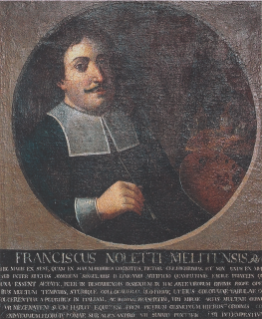Giuseppe Sacchi (17th Century) was an Italian painter of the Baroque period.

Musée des Beaux-Arts de Carcassonne
The son of the famous Andrea Sacchi, Giuseppe painted both historical canvases and portraits. He became a friar minor and died young.
Giuseppe Sacchi (17th Century) was an Italian painter of the Baroque period.

The son of the famous Andrea Sacchi, Giuseppe painted both historical canvases and portraits. He became a friar minor and died young.

Imola is a city and comune in the Metropolitan City of Bologna, located on the river Santerno, in the Emilia-Romagna region of northern Italy. The city is traditionally considered the western entrance to the historical region Romagna.

Andrea Sacchi was an Italian painter of High Baroque Classicism, active in Rome. A generation of artists who shared his style of art include the painters Nicolas Poussin and Giovanni Battista Passeri, the sculptors Alessandro Algardi and François Duquesnoy, and the contemporary biographer Giovanni Bellori.

The Accademia di San Luca is an Italian academy of artists in Rome. The establishment of the Accademia de i Pittori e Scultori di Roma was approved by papal brief in 1577, and in 1593 Federico Zuccari became its first principe or director; the statutes were ratified in 1607. Other founders included Girolamo Muziano and Pietro Olivieri. The Academy was named for Luke the Evangelist, believed to be the patron saint of painters.

Carlo Maratta or Maratti was an Italian painter, active mostly in Rome, and known principally for his classicizing paintings executed in a Late Baroque Classical manner. Although he is part of the classical tradition stemming from Raphael, he was not exempt from the influence of Baroque painting and particularly in his use of colour. His contemporary and friend, Giovanni Bellori, wrote an early biography on Maratta.

Agostino Scilla was an Italian Baroque painter, paleontologist, geologist, numismatist, and a pioneer in the study of fossils and in scientific illustration. In addition to his paintings, he published an early text on paleontology: La vana speculazione disingannata dal senso which was introduced to English audiences by William Wotton of the Royal Society in 1696. He was among the first to promote a scientific understanding of fossils in contrast to fantastic Biblical and divine interpretations.

Arrigo Sacchi is an Italian former professional football coach. He was twice manager of AC Milan, with great success. He won the Serie A title in his 1987–88 debut season and then dominated European football by winning back to back European Cups in 1989 and 1990. From 1991 to 1996, he was head coach of the Italy national team and led them to the 1994 FIFA World Cup Final, where they lost to Brazil in a penalty shoot-out.
Events from the year 1694 in art.

Pier Francesco Mola, called Il Ticinese was an Italian painter of the High Baroque, mainly active around Rome.
Events from the year 1599 in art.

Italy competed at the 1952 Summer Olympics in Helsinki, Finland. 231 competitors, 208 men and 23 women, took part in 114 events in 19 sports.

Filippo Lauri was an Italian painter of the Baroque period, active mainly in Rome.

The collections of the Pinacoteca Comunale di Cesena, in Cesena, Italy, contain works by:

Lazzaro Baldi was an Italian painter and engraver of the Baroque period, active mainly in Rome.

Tommaso Donini or Tommaso Dovini, called Il Caravaggino was an Italian painter active mainly in Rome. He was previously erroneously referred to as 'Tommaso Luini' as the 17th century artist biographer Giovanni Baglione referred to him as such in his Le Vite de’ Pittori of 1642. Donini painted altarpieces. He was a follower of Caravaggio.
Carlo Sacchi (1617–1706) was an Italian painter of the Baroque period.

Francesco Noletti, also known as Francesco Fieravino was an Italian still-life painter. He was often referred to by his nickname, Il Maltese.
Arte Informale is a term coined in 1950 by the French critic Michel Tapié to refer to the art movement that began during the mid-1940s in post-World War II Europe. This movement also paralleled the Abstract Expressionism movement that was taking place at the same time in the United States, and had ties to the Arte Povera movement. Sometimes referred to as Tachism, Art Autre or Lyrical Abstraction, it was a type of abstraction in which form became less important than that of the expressive impulses of the artist, and was opposed to the rationalism of traditional abstraction. The qualities of informal art explore the possibilities of gesture, materials, and signage as the basis of communication. Oftentimes art characterized as informal is executed spontaneously and the approach to painting and sculpture are generally gestural, performative, expressionistic and experimental. Certain artists such as Lucio Fontana, Alberto Burri and Emilio Vedova were crucial figures of this movement.
Sacchi is an Italian surname. Notable people with the surname include:
Arrigo is an Italian given name. Derived from the latin form Arrigus, already used in Tuscany in the XI century. Widely diffused during the Middle ages. It can refer to: